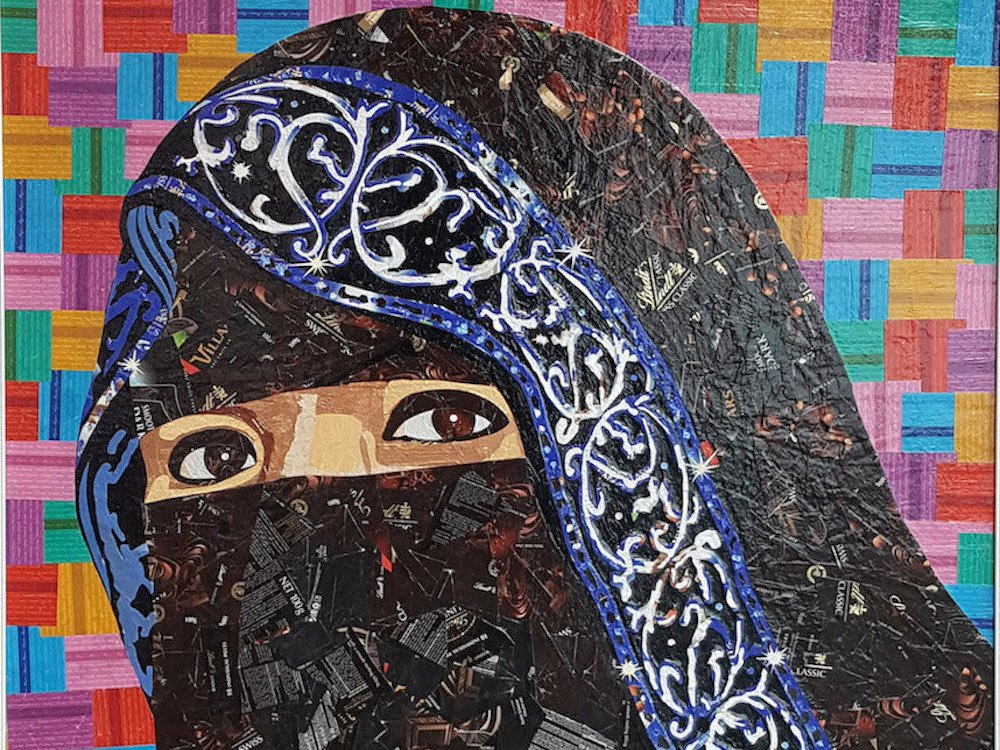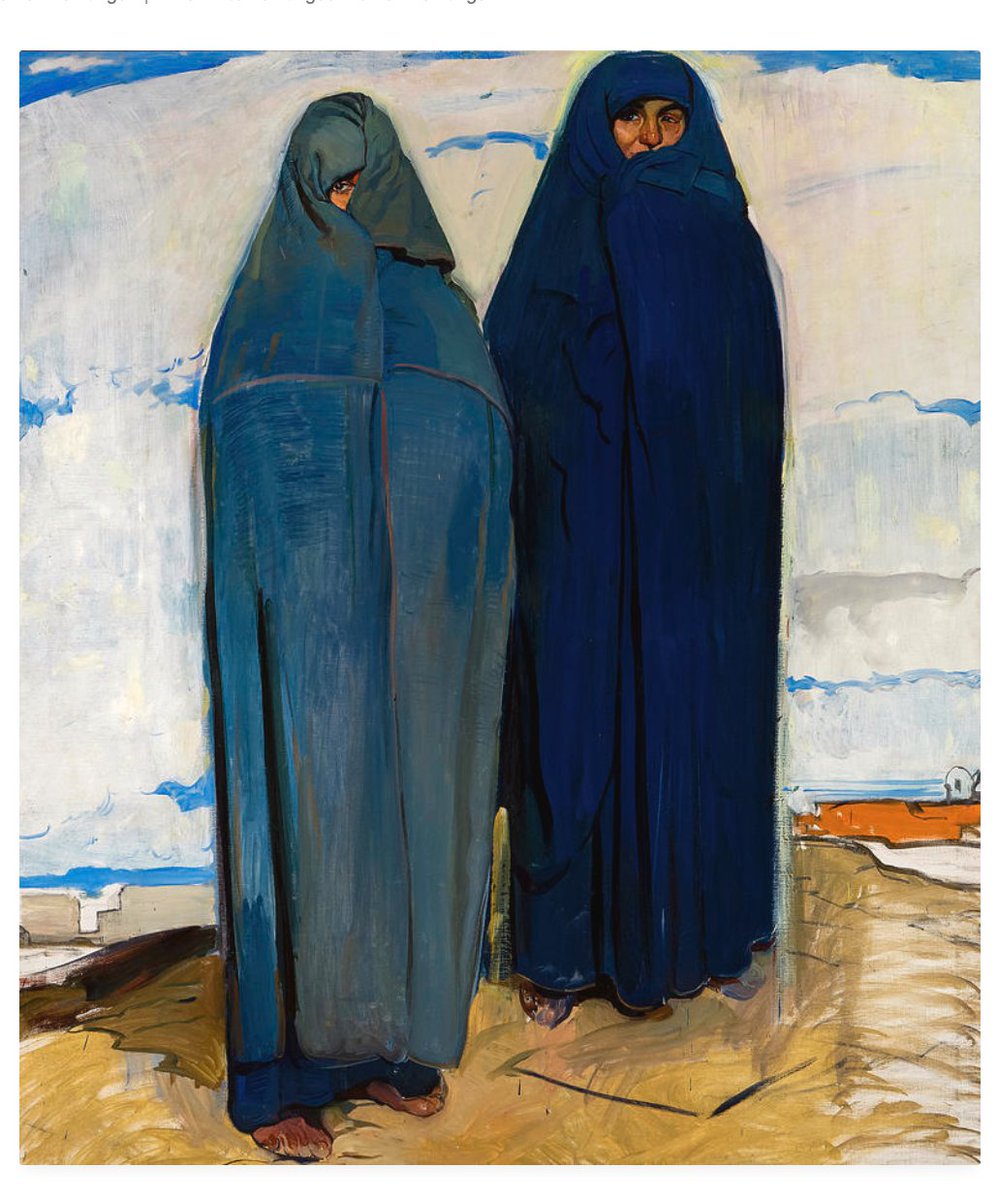Fifth in my series on Hafsa bint Sirin and the history that informs my novels, The Sufi Mystery Quartet. This begins my story of her life. Everyone, then and now, is telling a story about Hafsa to their own ends. I’m no different. This is my telling. Artist: Ghada Al-Rabea
My story is mainly based on the entries in Ibn Sa`d, Ibn al-Jawzi, and hadith that also tell the story that inspired the transmission of the report. But, fair warning, when I tell a story, I always go for the complex humanity, rather than the cleaned up version.
That may not be the Hafsa bint Sirin you want. I understand. There are a lot of other places you can read about her that don’t ask the kinds of questions I will ask and explore. Those are good, too. Seek out what feeds you the most nourishing food.
I begin: Hafsa bint Sirin was the child of parents who were enslaved and distributed as war spoils to the Prophet’s companions, Abu Bakr al-Siddiq and Anas b. Malik. 1
Because her parents were given as property to such significant companions, and after their release became dependents to those who had owned them, certain social advantages were open to her that might not have been for a free woman of no connection. 2
But let’s pause for a moment: She became a social elite and was proud of it, but her access to elite society and all the advantages that came with it were a result of exploitation by those very same elites. It’s not the same as being born into that social status. 3
While enslaved or as dependents, they were never “like family,” in any way that should allow us to forget the exploitation that got them there or that allows us to be comfortable with slavery. 3a
The wealth of legal injunctions discussing the rights an owner had over those they enslaved and innumerable calls to be “good” to enslaved people in piety literature demonstrates just how often the free had to be reminded to treat those they enslaved well. 3b
The whole of an entry heralding a woman’s piety amounts to her not giving in to whipping an enslaved boy who had erred. “She ran after him with her whip, but when she caught him she threw it down, saying, “Awareness of God never departs from one who tries to heal their anger.” 3c
Nor do I want to minimize the Hafsa’s own purchase of a woman for household labour whose experience will be addressed in a later thread. 3d
I make this point because I do not want the successful story of Hafsa’s family to give the impression that Muslims who enslaved others were less ethically culpable than non-Muslims throughout history. Thats a lot for us to sit with, but I don& #39;t have your answer for you. 3e
Okay, then. If you keep that in mind, we can continue on. 3f
I begin again. It is often said that with the coming of Islam Arab tribal social hierarchies were upended. While this is true to some degree, in practice, the social levelling that came with Islam was more of a redistribution of status than the elimination of it. 4
Social status came in many modes and often hand in hand with great piety and great poverty. Those who joined Muhammad early on and fought alongside him had the greatest rank. 5
Those physically nearest to him or his companions had the greatest opportunity to learn about him and transmit his teachings. 6
So even an enslaved woman in a household of one of the Prophet’s Companions would have been able to establish higher social connections based on proximity to these elites than a wealthy free man who lived in outside Medina. 7
First as enslaved servants and then client dependents of Abu Bakr and Anas ibn Malik, Hafsa’s parents, Safiyya and Sirin, were able to claim such connections and Sirin was eager to make use of them. 8
Sirin had run a coppersmith business before he was taken captive and was eager to reclaim his lost status. Safiyya was the perfect wife in this regard and his clientage-dependent relationship with Anas ibn Malik made it happen. 9
She was an appropriate match as a freed woman, not free born, and would raise him in status as a client-dependent to the Prophet’s best friend and father-in-law, the first caliph of the Muslim community, Abu Bakr al-Siddiq. 10
Throughout her life, Hafsa’s mother enjoyed relationships with the extended family of Abu Bakr and the Prophet’s wives. She was so well-esteemed, it is said that when she died three of Muhammad’s wives prepared her body for burial out along with other notable companions. 11
Anas was a highly regarded companion, a transmitter of many hadith, but there were divisions in the early community over the ethics of holding wealth and he was not on the side of pious poverty. 12
It is reported that Anas demanded 40,000 dirhams or more from Sirin for his freedom. Sirin could hardly afford this. He was forced to go to ʿUmar ibn al-Khattab, Muhammad’s close friend and the third caliph, for help facilitating his release. 13
Anas made good by paying for the celebration, as was his social obligation. The depiction of Sirin’s wedding to Safiyya bears the mark of a lavish and somewhat awkward event. The celebration lasted seven days which, ostentatious by prophetic standards which called for less. 14
We get a hint of the disagreement over pious wealth and pious poverty in the early Muslim community in the story of Ubayy b. Kaʿb who stopped by, bringing other companions with him and praying for the couple. 15
Ubayy b. Kaʿb was an early companion of the Prophet, one of his scribes and the possessor of a personal copy of the Qur’an. But notably Ubayy refused to eat at the celebration, saying he was fasting, which could be read as a slight directed at Anas and by connection, Sirin. 16
Nevertheless, Anas held great status and was able to give Sirin and his spiritually and intellectually precocious children the best opportunities for success. 17
Hafsa, her two sisters Umm Sulaym and Karima, and her brothers Muhammad and Yahya–and her half-siblings, some of whom also transmitted hadith–grew up in the deeply intertwined social, scholarly, and devotional circles of the Companions and Followers in Medina and Basra. 18
Because her family had access to these elite social circles, Hafsa had the opportunity to memorize the Qur’an by the age of twelve as well as sit with companions such as Umm ʿAtiyya, Abu al-ʿAliya, and Salman b. ʿAmir from whom she transmits hadith. 19
Ultimately, she became known as a reliable scholar and a woman of great piety and was taken seriously in influential circles (as we saw when she argued the legal status of women’s right to pray the ʿeid prayer at the mosque). 20 https://twitter.com/waraqamusa/status/1376180236413513737?s=20">https://twitter.com/waraqamus...
As a mark of Anas’s obligation but more so favour to Sirin, he contracted a second marriage for Sirin to a freed woman, then, again decades later, to one of his nieces as a third or fourth wife, this final marriage elevated Sirin from client to family. 21
Given Sirin’s multiple marriages, Hafsa grew up around many siblings in what was likely to have been a bustling compound of rooms. 22
Her father tried to make space for his children’s devotional needs. It is said that he built separate prayer spaces of wooden planks for her, Muhammad, and Yahya. 23
But such quiet spaces devoted to piety did not keep Hafsa from family drama arising from Sirin’s marriages. 24
When Anas offered Sirin his niece in marriage, Hafsa was supportive of the match despite her mother’s clear objection. 25
Don’t be surprised that she sided with her father. She felt the advantage of them given her close relationships with her siblings and the social ties it further afforded them. Marriage was primarily a social arrangement, not solely a matter of legitimating desire or love. 26
Whichever the case, it is reported that when given the news, she congratulated her father for the marriage that would raise them from a clientage relationship to family with Anas. 27
But when Hafsa delivered the news to her mother, Safiyyah was incensed. She may have been the first wife, but the final one as Anas’s family would be the most prized. She insulted Hafsa for supporting her father and retorted, “Tell your father, ‘May you be distant from God!”’ 28
I& #39;ll continue with the story of Hafsa bint Sirin& #39;s life next week, how she became a scholar, more on her family, and some of the tragedies of her life. Artist: Antonio Ortiz Echague
As always if you like the questions I raise, the way I think about history, and the human threads of the lives of these early folk I tease out, you might like my historical mysteries set in Abbasid era Baghdad. The Sufi Mysteries Quartet. https://twitter.com/waraqamusa/status/1378004836629745667?s=20">https://twitter.com/waraqamus...

 Read on Twitter
Read on Twitter



